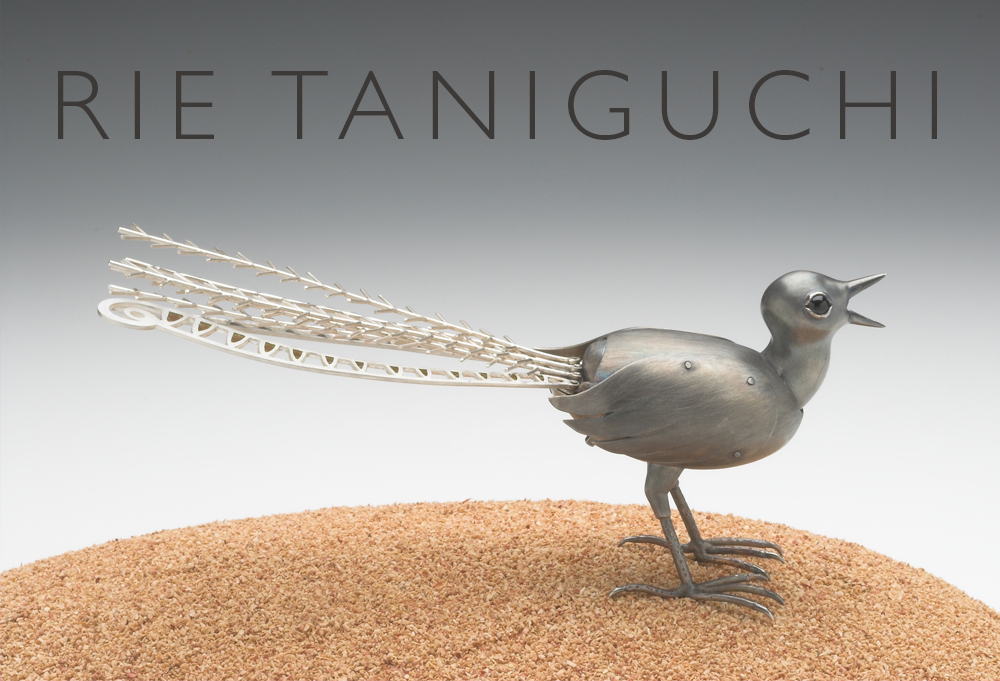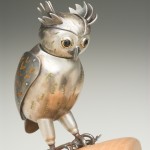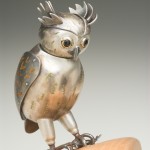Rie Taniguchi: Spotlight Exhibition
December 3, 2016 – January 31, 2017
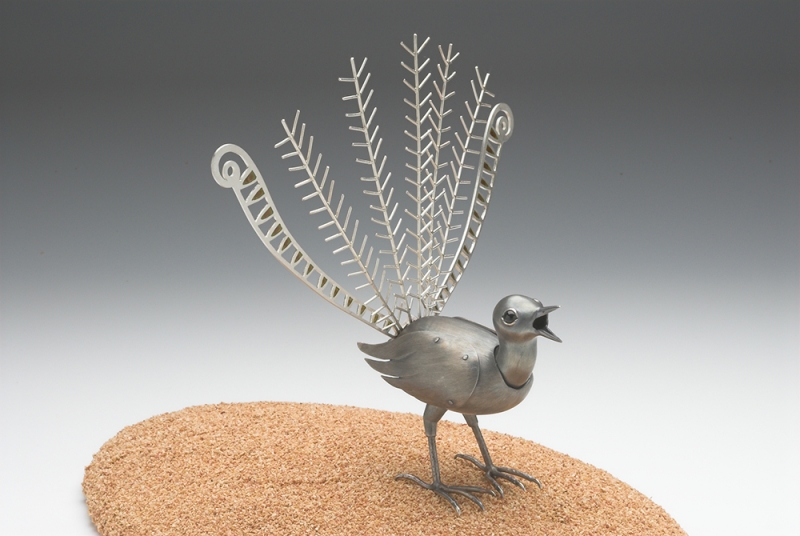
Rie Taniguchi
Lyre Bird Sings
Sculpture. Sterling silver, enamel, onyx, stainless steel spring, silicone, MDF, sawdust
5.1" x 2.2" x 1.2"
“There are only two species of Lyrebirds: Superb Lyrebird and Albert’s Lyrebird. Technically they are passerines, yet in shape, colour and in their shy, ground-dwelling, solitary, forest-stalking habits, lyrebirds rather resemble tawny coloured gamebirds.
“They were hunted for their tail feathers in the last century, together with habitat loss, these pressures weighed heavily on both species. But due to careful management of the species and its habitat, the species now have stable populations. Even so, they are vulnerable to cats and foxes.
“Lyrebirds’s syrinx confers on the two species a gift for imitation of exquisite accuracy. About three quarters of their song output is mimicry. Both birds routinely incorporate pitch-perfect renderings of not only many of their avian forest neighbours, but animals and man-made sounds. You can find videos of them singing on youtube.
“Male lyrebirds call mostly during winter, when they construct and maintain an open arena-mound in dense bush, on which they sing and dance in courtship. My piece ‘Lyrebird Sings’ is modelled on a male Superb Lyrebird.”
Photo: Joël Degen
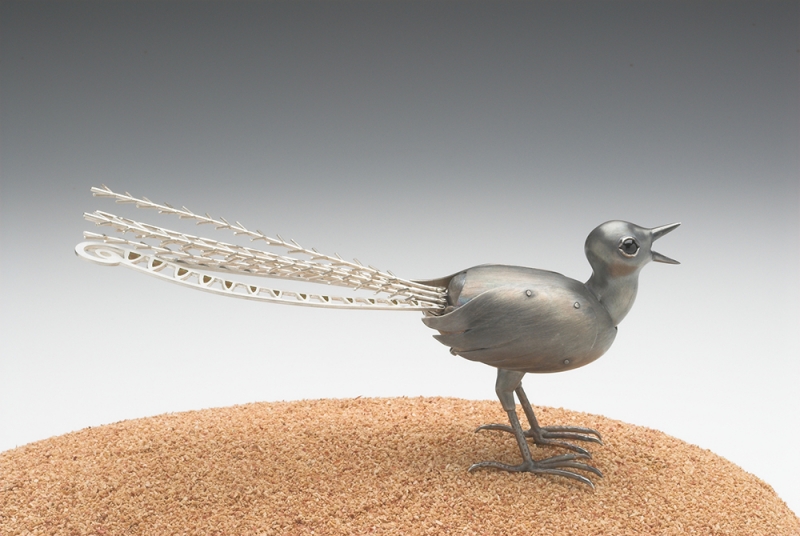
Rie Taniguchi
Lyre Bird Sings
Sculpture. Sterling silver, enamel, onyx, stainless steel spring, silicone, MDF, sawdust
5.1" x 2.2" x 1.2"
“There are only two species of Lyrebirds: Superb Lyrebird and Albert’s Lyrebird. Technically they are passerines, yet in shape, colour and in their shy, ground-dwelling, solitary, forest-stalking habits, lyrebirds rather resemble tawny coloured gamebirds.
“They were hunted for their tail feathers in the last century, together with habitat loss, these pressures weighed heavily on both species. But due to careful management of the species and its habitat, the species now have stable populations. Even so, they are vulnerable to cats and foxes.
“Lyrebirds’s syrinx confers on the two species a gift for imitation of exquisite accuracy. About three quarters of their song output is mimicry. Both birds routinely incorporate pitch-perfect renderings of not only many of their avian forest neighbours, but animals and man-made sounds. You can find videos of them singing on youtube.
“Male lyrebirds call mostly during winter, when they construct and maintain an open arena-mound in dense bush, on which they sing and dance in courtship. My piece ‘Lyrebird Sings’ is modelled on a male Superb Lyrebird.”
Photo: Joël Degen
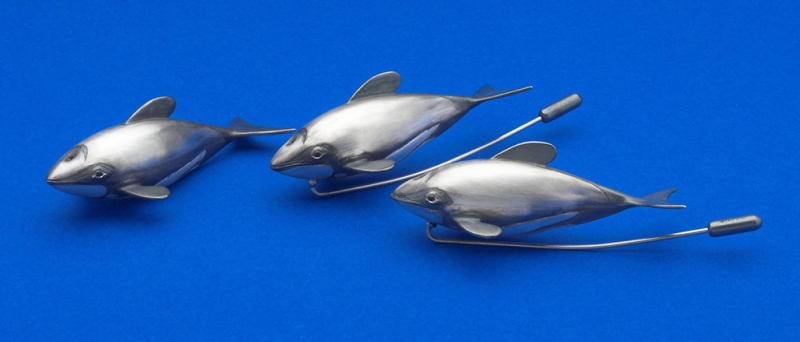
Rie Taniguchi
Hector's/Maui's Dolphin
Brooches. Sterling silver, enamel paint, stainless steel pins
2.2" x 1.1" x .7"
“Hector’s or Maui’s Dolphin is the smallest of all dolphins, named after Sir James Hector, Victorian director of Wellington’s colonial Museum. They prefer the sanctuary of cloudy, coastal waters of New Zealand as protection against predators, but those same waters make them vulnerable to human actions, such as noise from boat traffic, chemical and agricultural pollution and gill nets.
“They are small and fleet, but not as acrobatic as their bigger cousins. The way the dolphins move, their markings and their rounded dorsal fins make them somehow cartoon-like. They generally live in shallow waters less than 100m deep, in groups of two to eight individuals. The dolphins use high frequency echolocation clicks and feed on small prey, typically under 10cm long.
“North Island subspecies known as Maui’s Dolphin only constitute around fifty individuals and are the most endangered of any cetacean, unable to sustain any more losses They only occupy a small ocean space, ranked as nationally critical by the Department of Commerce and critically endangered by the International Union for Conservation of Nature (IUCN). Hector’s/Maui’s dolphin is considered to be one of the world’s rarest dolphin species. Both dolphin subspecies have a lifespan of only about 20 years, have a low reproduction rate (calving every 2-3 years) and late onset of sexual maturity (7-9 years). These factors result in a low maximum population growth rate, which put Hector’s and Maui’s dolphin at risk from even low levels of human-induced mortality.”
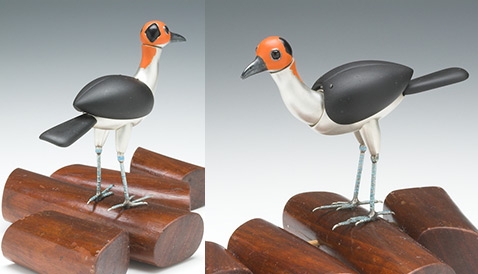
Rie Taniguchi
Picathartes
Sculpture. Sterling silver, enamel, enamel paint, onyx, ebony, stainless steel spring, wood base
3" x 3.9" x 1.1.1"
“There are only two species of Picathartes and among globetrotting birders, they are two of the most sought-after birds on earth. My piece is modelled on the white-necked Picathartes. The other is grey-necked Picathartes. They live in the rainforest of east and central Africa.
“Sir David Attenborough first filmed the bird in 1950’s for the BBC. I recently saw the film, but I first saw Picathartes in the BBC series ‘Africa’ shown in 2013, and was instantly intrigued. I couldn’t believe what I saw. Their appearance, how they move… They were supernatural beings in local folklore and I could see why. Largely silent, they bound through the trees and forest floor, partly floating on broad wings and partly springing in airy hops. Very few humans have seen these birds because of their secrecy. Deforestation and habitat disturbance severely affected their range. Sadly the folklore which once had a protective function is dying out.
“I had to make one.”
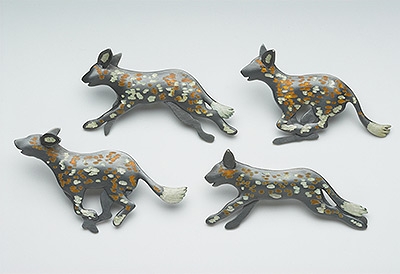
Rie Taniguchi
Lycaon Pictus
Brooches. Sterling silver, enamel, stainless steel pins
2.9" x 1.4", 2.8" x 1.5", 2.8" x 1.3", 2.5" x 1.7"
“The African wild dog, African hunting dog, or African painted dog is a canid native to Sub-Saharan Africa. It is the largest of its family in Africa, and the only extant member of the genus Lycaon, which is distinguished from Canis by its fewer toes and dentition, which is highly specialised for a hypercarnivorous diet. Each animal has its own unique coat pattern, and all have big, rounded ears.
“It is classed as endangered by the IUCN, as it has disappeared from much of its original range caused by habitat fragmentation, prosecution by humans and diseases.
“The African wild dog is a highly social animal, living in packs with separate dominance hierarchies for males and females. They are known to share food and to assist weak or ill members. Social interactions are common, and the dogs communicate by touch, actions, and vocalisations. Uniquely among social carnivores, it is the females rather than the males that scatter from the natal pack once sexually mature, and the young are allowed to feed first on carcasses. The species is a specialised diurnal hunter of antelopes, which it catches by chasing them to exhaustion. They are formidable cooperative hunters, also tackle larger prey particularly if their quarry is ill or injured.“
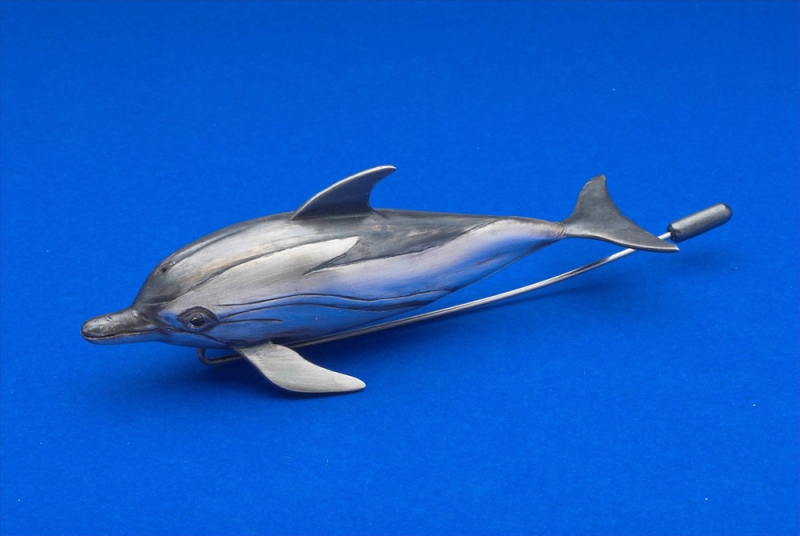
Rie Taniguchi
Striped Dolphin
Brooch. Sterling silver, stainless steel pin, enamel paint
3.25" x 1.1" x .9"
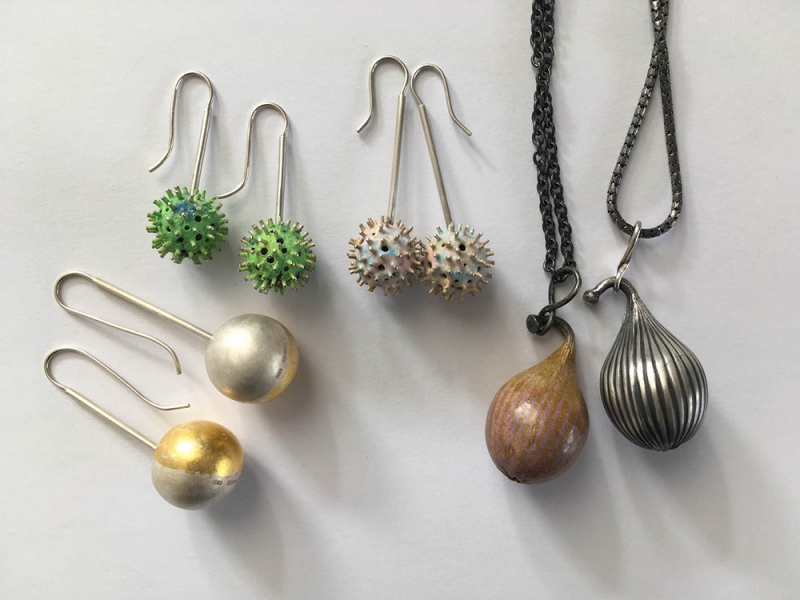
Rie Taniguchi
Moon Earrings, Conker Earrings, Fig Pendants
Moon Earrings: Sterling silver, gold foil
Conker Earrings: Sterling silver, enamel
Fig Pendants: Sterling silver
Moon Earrings: .7" diameter x 2.2" long
Conker Earrings: .6" diameter
Fig Pendants: .75" x .8" x 1.3"
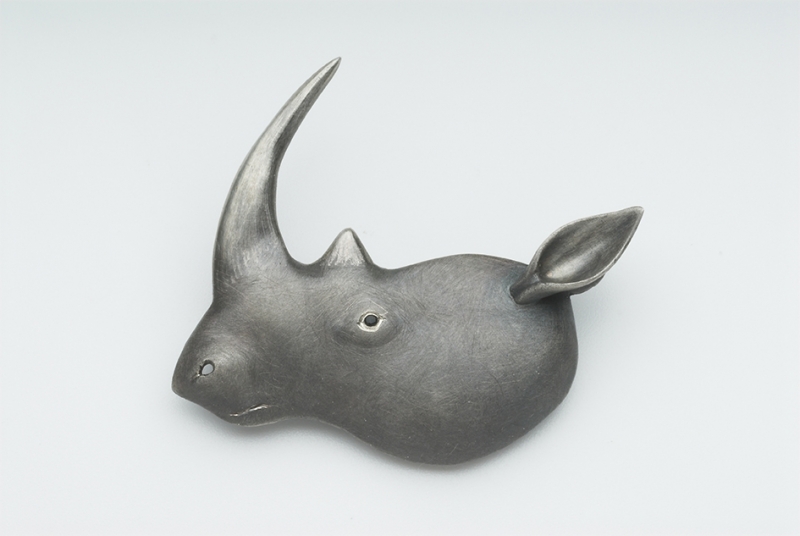
Rie Taniguchi
Rhino Head: My Horn Is No Medicine
Brooch. Silver, stainless steel pin, enamel paint
1.5" x 1.7" x .4"
Photo: Joël Degen

Rie Taniguchi
Lyre Bird Sings
Sculpture. Sterling silver, enamel, onyx, stainless steel spring, silicone, MDF, sawdust

Rie Taniguchi
Lyre Bird Sings
Sculpture. Sterling silver, enamel, onyx, stainless steel spring, silicone, MDF, sawdust

Rie Taniguchi
Hector’s/Maui’s Dolphin
Brooches. Sterling silver, enamel paint, stainless steel pins

Rie Taniguchi
Picathartes
Sculpture. Sterling silver, enamel, enamel paint, onyx, ebony, stainless steel spring, wood base

Rie Taniguchi
Moon Earrings, Conker Earrings, Fig Pendants
Moon Earrings: Sterling silver, gold foil
Conker Earrings: Sterling silver, enamel
Fig Pendants: Sterling silver

Rie Taniguchi
Rhino Head: My Horn Is No Medicine
Brooch. Silver, stainless steel pin, enamel paint
- IMAGES:
- /

Rie Taniguchi
Lyre Bird Sings
Sculpture. Sterling silver, enamel, onyx, stainless steel spring, silicone, MDF, sawdust
5.1" x 2.2" x 1.2"

Rie Taniguchi
Lyre Bird Sings
Sculpture. Sterling silver, enamel, onyx, stainless steel spring, silicone, MDF, sawdust
5.1" x 2.2" x 1.2"

Rie Taniguchi
Hector's/Maui's Dolphin
Brooches. Sterling silver, enamel paint, stainless steel pins
2.2" x 1.1" x .7"

Rie Taniguchi
Picathartes
Sculpture. Sterling silver, enamel, enamel paint, onyx, ebony, stainless steel spring, wood base
3" x 3.9" x 1.1.1"

Rie Taniguchi
Lycaon Pictus
Brooches. Sterling silver, enamel, stainless steel pins
2.9" x 1.4", 2.8" x 1.5", 2.8" x 1.3", 2.5" x 1.7"

Rie Taniguchi
Striped Dolphin
Brooch. Sterling silver, stainless steel pin, enamel paint
3.25" x 1.1" x .9"

Rie Taniguchi
Moon Earrings, Conker Earrings, Fig Pendants
Moon Earrings: Sterling silver, gold foil
Conker Earrings: Sterling silver, enamel
Fig Pendants: Sterling silver
Moon Earrings: .7" diameter x 2.2" long
Conker Earrings: .6" diameter
Fig Pendants: .75" x .8" x 1.3"

Rie Taniguchi
Rhino Head: My Horn Is No Medicine
Brooch. Silver, stainless steel pin, enamel paint
1.5" x 1.7" x .4"

Rie Taniguchi
Lyre Bird Sings
Sculpture. Sterling silver, enamel, onyx, stainless steel spring, silicone, MDF, sawdust

Rie Taniguchi
Lyre Bird Sings
Sculpture. Sterling silver, enamel, onyx, stainless steel spring, silicone, MDF, sawdust

Rie Taniguchi
Hector’s/Maui’s Dolphin
Brooches. Sterling silver, enamel paint, stainless steel pins

Rie Taniguchi
Picathartes
Sculpture. Sterling silver, enamel, enamel paint, onyx, ebony, stainless steel spring, wood base

Rie Taniguchi
Moon Earrings, Conker Earrings, Fig Pendants
Moon Earrings: Sterling silver, gold foil
Conker Earrings: Sterling silver, enamel
Fig Pendants: Sterling silver

Rie Taniguchi
Rhino Head: My Horn Is No Medicine
Brooch. Silver, stainless steel pin, enamel paint
The work of metalsmith Rie Taniguchi embraces nature. Her charming figures incorporate sterling silver, gold, semiprecious stones and ingenious spring-loaded designs. These playful commentaries on the animal kingdom include wearable elements, and reflect Taniguchi’s interest in wildlife, the environment and traditional folktales.
STATEMENT
I make objects to look at and/or to wear, mainly in the form of various living creatures and have been focusing on endangered species. I draw my inspiration freely from everything I see, read and hear. My main interests and concerns, aside from arts, are in environmental conservation and wildlife. News, documentaries, folk tales and myths all come into consideration. I try to express the essence of life with satire and playfulness, showing animals in their environments or in a situation when possible, and to make it life like rather than realistic. I am discovering that real life forms are more fantastic than the fantastical and more challenging to make. Images from my childhood still influence me through the experience of making numerous drawings. I draw from photographs, films and real life before drawing from memory and designing. I have developed softer, more organic shapes using a mixture of techniques such as press forming, raising, constructing and carving with silver.
